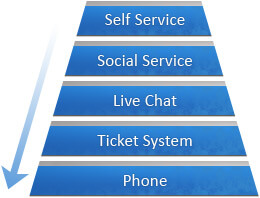The SmarterTrack Philosophy
Customers judge the quality of an organization's customer service on the basis of availability, the number of channels offered by the organization for contacting customer service (and the transparency of those outlets), and the speed at which the customer can get a response to their issue. For this reason, companies can no longer rely on a single channel to deliver customer service to their customers. With SmarterTrack, companies can reach out to, and be contacted by, their customers through many different communications channels and even guide their customers to the most cost-effective and efficient method.
To maximize the efficiency of multichannel interactions, companies need to help customers determine the best channels to use by guiding them through the sales and support process. In doing so, companies can shape when and how they interact with the people who buy their products and services -- ultimately balancing the preferences of their customers with the economics of the company's communication channels.
The Customer Service Channels
In general, contemporary customer service channels should operate as a funnel, with customers utilizing the least costly channels first. Ideally, companies should aim to encourage customers to use channels in this order:
- Self-service (Knowledge Base articles, help files, white papers, news items, website information, etc.)
- Social service (Community forums, social networking sites, blogs, etc.)
- Live chat
- Ticket system
- Phone
Given that automated, self-service, and Web-based communications are inherently more efficient than those that require immediate agent attention, it makes sense to encourage as many communications as possible through these types of channels. (I.e., the first 4 in the list, above.) This provides customers with the information they need while reserving agent resources to deal with highly complex issues.
Of course, some customers are going to work their way through all these customer service channels before resolving their issue. That's OK as long as the company can successfully document the steps taken to resolve the issue and use this information to improve customer interactions at the top of the funnel. This will ensure that future interactions have the opportunity to be resolved earlier in the process next time.
For example, if an issue has escalated through the channels to a phone support incident before it is resolved, the company can now capture the data, search criteria, and steps taken to resolve the issue, and push that information to its employees. This creates an opportunity to update the arsenal of resources to more efficiently and cost-effectively serve its customers. Two weeks later, when another customer with the same issue enters a similar search query in the Knowledge Base or types certain keywords into the live chat window, the information will be available immediately and can be displayed to the customer or agent in real time. As a result, the customer will find a solution two steps earlier than the previous customer did, instantly bringing efficiency to the customer service team and increasing customer satisfaction.
Over time, the constant feedback from tickets, Knowledge Base articles, social media posts, and KB or community searches dynamically increases the number of resolutions occurring closer to the top. The increasing efficiency can result in tens of thousands of dollars in saved costs and an increase in customer satisfaction as customers receive detailed answers earlier in the customer service cycle.
Inefficient Service Channel Flow

| Request | Dollars* |
|---|---|
| 500 | $125 |
| 1000 | $500 |
| 2000 | $4,000 |
| 2500 | $23,750 |
| 4000 | $108,000 |
| Total Cost: | $136,375 |
Efficient Service Channel Flow

| Request | Dollars* |
|---|---|
| 4000 | $1,000 |
| 2500 | $1,250 |
| 2000 | $4,000 |
| 1000 | $9,500 |
| 500 | $13,500 |
| Total Cost: | $29,250 |
* Based upon $0.25 per self service, $0.50 per social service, $2.00 per live chat, $9.50 per ticket/email, and $27.00 per phone request.
Managing Channels From One Application
While some companies may deploy multiple customer service channels through a variety of solutions, SmarterTrack allows companies to operate and manage these channels from a single application. In addition to making channel management more efficient, this provides companies with increased access to business intelligence and allows managers to identify relationships between various customer service channels.
For example, SmarterTrack can report on live chats, tickets, and Who's On results to determine how customers are finding information on a website and compare their ability to use that information. Similarly, a company can utilize custom fields to capture customer-specific information (such as physical location, product serial number, server location, etc.). Reports can then be configured to identify specific areas of concern (locate errant networks, identify faults to the manufacturing location or supplier, identify agents struggling with certain topics/issues, etc.).